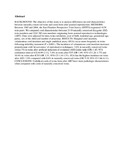Umbilical cord anomalies are more frequent in twins after assisted reproduction.

View/
Date
2007Author
Delbaere, I
Goetgeluk, S
Derom, C
De Bacquer, D
De Sutter, P
Temmerman, M
Type
ArticleLanguage
enMetadata
Show full item recordAbstract
BACKGROUND:
The objective of this study is to analyse differences in cord characteristics between naturally conceived twins and twins born after assisted reproduction.
METHODS:
Between 1985 and 2004, the East Flanders Prospective Twin Survey (EFPTS) registered 4159 twin pairs. We compared cord characteristics between 2119 naturally conceived dizygotic (DZ) twin members and 2243 DZ twin members originating from assisted reproductive technologies (ART). Data were adjusted for intra-twin correlation, year of birth, maternal age, gestational age, parity, sex of the child and number of placentas.
RESULTS:
Marginal cord insertion, velamentous cord insertion and single umbilical artery (SUA) occur more frequently in twins following infertility treatment (P < 0.001). The incidence of velamentous cord insertion increases proportionate with 'invasiveness' of reproductive techniques: 3.6% in naturally conceived twins versus 5% in twins after artificial induction of ovulation (AIO) [odds ratio (OR) 1.45; 95% confidence interval (CI) 0.99-2.11], 7.4% in twins after IVF (OR 1.49; 95% CI 1.26-1.77) and 10.4% in twins after ICSI (OR 1.31; 95% CI 1.14-1.51). SUA has the highest incidence in twins after AIO: 1.9% compared with 0.6% in naturally conceived twins (OR 3.19; 95% CI 1.66-6.11).
CONCLUSIONS:
Umbilical cords of twins born after ART have more pathologic characteristics when compared with cords of naturally conceived twins.
URI
hinari-gw.who.int/whalecomwww.ncbi.nlm.nih.gov/whalecom0/pubmed/17720701http://erepository.uonbi.ac.ke:8080/xmlui/handle/123456789/40645
Citation
Hum Reprod. 2007 Oct;22(10):2763-7. Epub 2007 Aug 24.Publisher
University of Nairobi Faculty of medicine
Collections
- Faculty of Health Sciences (FHS) [10378]
